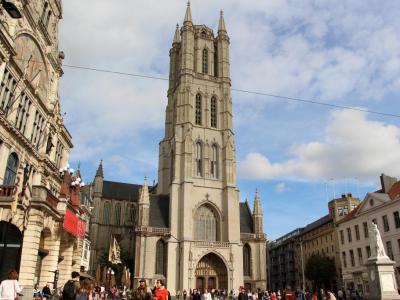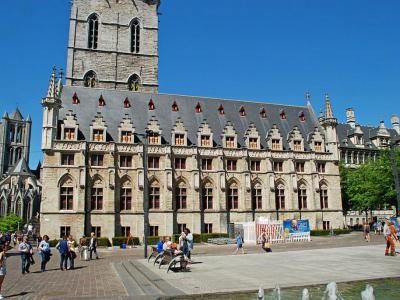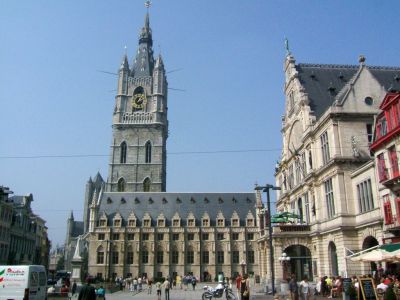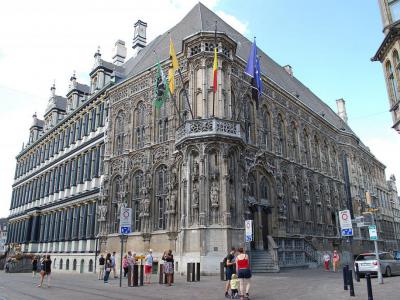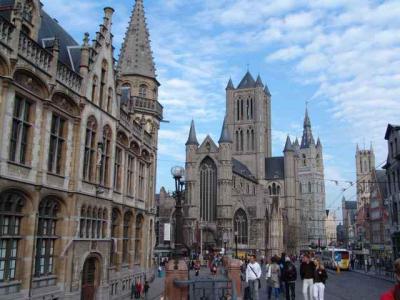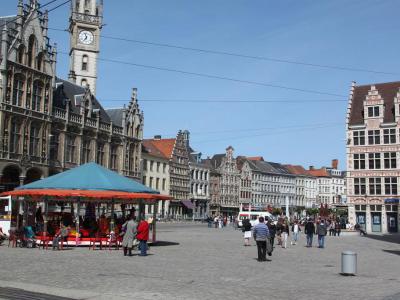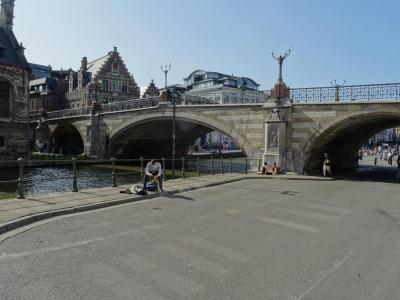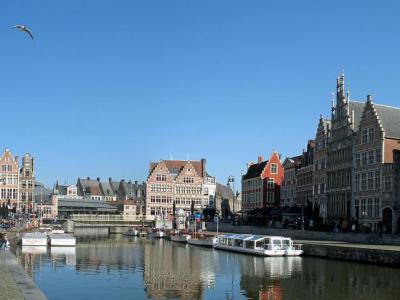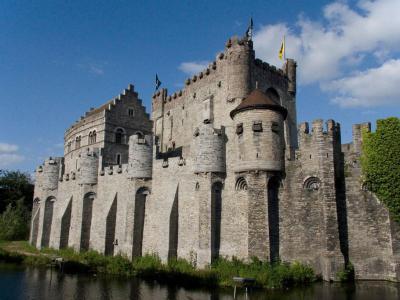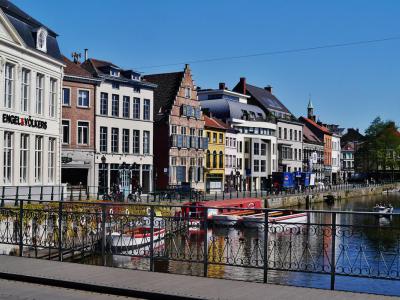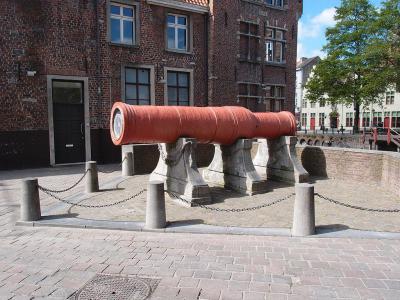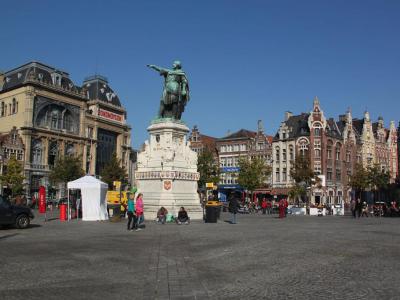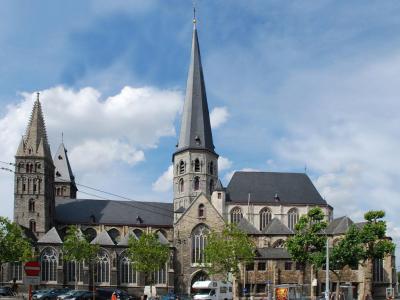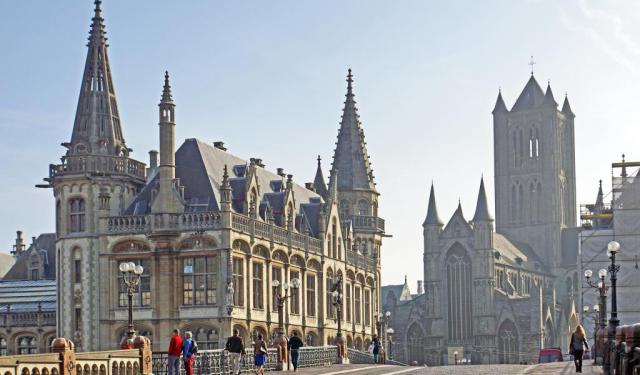
Ghent Introduction Walking Tour (Self Guided), Ghent
Some historians believe "Ghent" comes from the Celtic word, "ganda." "Ganda" meant a confluence, as with two rivers. There are traces of human settlements as far back as the stone age at the confluence of the rivers Scheldt and Leie in Belgium.
With the Frankish invasions at the end of the 4th century AD, the Celtic language was replaced by Old Dutch and this marked the beginning of Ghent. In 650 Saint Amand founded two abbeys in Ghent. They were Saint Peter's and Saint Bavo's. Under the empire of Charlemagne, the city expanded as a religious and commercial center.
The Vikings paid less than cordial visits to the city in 851 and 879, but Ghent survived. By the 11th century it was virtually a city state. By the 13th century Ghent was second in size only to Paris. Wool, fabric and grain had changed the area into a highly developed commercial zone.
In 1453 Ghent was defeated in a rebellion against taxes by Philip the Good of Burgundy. In 1539 Charles V, Holy Roman Emperor, suppressed another tax rebellion. He paraded the nobles of the city wearing nooses. They were thereafter called "Stroppendragers" ("Noose bearers").
The 16th, 17th and 18th centuries brought devastations by Spain, Austria, and France. Finally, after Waterloo, Ghent and Flanders became a part of the United Kingdom of the Netherlands. This period lasted 15 years until the Belgian Revolution in 1830.
Ghent is a center of Belgian industry and a major seaport. Horticulture, textiles, manufacturing and tourism have brought prosperity but Ghent has retained great reminders of the past.
In the center of the city is the 292 foot 14th century Bell tower with a carillon of 52 bells. The Flamboyant Gothic Town Hall (1518-1535) combines Gothic with Renaissance styles. Feudalism is represented in the gloomy castle Gravensteen (1180), one time home to the Counts of Flanders.
The towers of Gothic Saint Bavo, Saint Nicholas and the Belfry dominate the skyline. Come and walk along the quais of the canalized Leie river and lose yourself among the medieval facades of the ancient guild houses and the incomparable history of Ghent.
With the Frankish invasions at the end of the 4th century AD, the Celtic language was replaced by Old Dutch and this marked the beginning of Ghent. In 650 Saint Amand founded two abbeys in Ghent. They were Saint Peter's and Saint Bavo's. Under the empire of Charlemagne, the city expanded as a religious and commercial center.
The Vikings paid less than cordial visits to the city in 851 and 879, but Ghent survived. By the 11th century it was virtually a city state. By the 13th century Ghent was second in size only to Paris. Wool, fabric and grain had changed the area into a highly developed commercial zone.
In 1453 Ghent was defeated in a rebellion against taxes by Philip the Good of Burgundy. In 1539 Charles V, Holy Roman Emperor, suppressed another tax rebellion. He paraded the nobles of the city wearing nooses. They were thereafter called "Stroppendragers" ("Noose bearers").
The 16th, 17th and 18th centuries brought devastations by Spain, Austria, and France. Finally, after Waterloo, Ghent and Flanders became a part of the United Kingdom of the Netherlands. This period lasted 15 years until the Belgian Revolution in 1830.
Ghent is a center of Belgian industry and a major seaport. Horticulture, textiles, manufacturing and tourism have brought prosperity but Ghent has retained great reminders of the past.
In the center of the city is the 292 foot 14th century Bell tower with a carillon of 52 bells. The Flamboyant Gothic Town Hall (1518-1535) combines Gothic with Renaissance styles. Feudalism is represented in the gloomy castle Gravensteen (1180), one time home to the Counts of Flanders.
The towers of Gothic Saint Bavo, Saint Nicholas and the Belfry dominate the skyline. Come and walk along the quais of the canalized Leie river and lose yourself among the medieval facades of the ancient guild houses and the incomparable history of Ghent.
How it works: Download the app "GPSmyCity: Walks in 1K+ Cities" from Apple App Store or Google Play Store to your mobile phone or tablet. The app turns your mobile device into a personal tour guide and its built-in GPS navigation functions guide you from one tour stop to next. The app works offline, so no data plan is needed when traveling abroad.
Ghent Introduction Walking Tour Map
Guide Name: Ghent Introduction Walking Tour
Guide Location: Belgium » Ghent (See other walking tours in Ghent)
Guide Type: Self-guided Walking Tour (Sightseeing)
# of Attractions: 13
Tour Duration: 2 Hour(s)
Travel Distance: 1.7 Km or 1.1 Miles
Author: vickyc
Sight(s) Featured in This Guide:
Guide Location: Belgium » Ghent (See other walking tours in Ghent)
Guide Type: Self-guided Walking Tour (Sightseeing)
# of Attractions: 13
Tour Duration: 2 Hour(s)
Travel Distance: 1.7 Km or 1.1 Miles
Author: vickyc
Sight(s) Featured in This Guide:
- Sint-Baafskathedraal (St Bavo's Cathedral)
- Lakenhalle (Cloth Hall)
- Belfort (Belfry of Ghent)
- Stadhuis (Town Hall)
- Sint-Niklaaskerk (St. Nicholas Church)
- Korenmarkt (Wheat Market)
- St Michael's Bridge
- Gaslei (Grass Quai) & Korenlei (Wheat Quai)
- Gravensteen Castle
- Kraanlei and Patershol Quarter
- Dulle Griet (Mad Meg Supergun)
- Vrijdagmarkt (Friday Market Square)
- St-Jacobskerk (St James' Church)
1) Sint-Baafskathedraal (St Bavo's Cathedral) (must see)
In 1566 the Calvanist iconoclasts were on a rampage in the Netherlands. Raiding churches, they found a target rich environment. Stained glass windows, statues, artwork, everything had to go. Three days before they got to St. Bavo's, artwork was hidden in the crypt and St. Bavo's was mostly spared.
St. Bavo's Cathedral or Saint-Baafskathedraal, is a 292 foot tall Catholic cathedral in Ghent. It is built on the site of the wooden Chapel of Saint John the Baptist, founded in 942 by Transmanus, Bishop of Tournai and Noyon. Construction of a new Romanesque church began there in 1150.
In the 14th through the 16th centuries ambitious Gothic renovations were added. On top of the lower Romanesque church a high Gothic choir and an enormous vault with tall windows was built. Around the choir is an ambulatory and 14 chapels. The 292 foot tower was erected in 1534. The church became a cathedral in 1569. A new nave was added by 1590.
Among the treasures that were saved from the iconoclasts of 1566 is the Famous Ghent Altarpiece, a painted polyptych by the van Eyck brothers Jan and Hubert in 1432.
Other artists represented in the cathedral are Peter Paul Rubens and Lucas de Heere. Frans Pourbus the Elder created 14 panels of The History of Saint Andrew (1572). There are three paintings by Caspar de Crayer, including The Beheading of John the Baptist. Eleven grisailles of the Old and New Testaments adorn the choir above the stalls.
The high choir is an awesome part of the interior. It has stalls for members of the Chapter of Saint-Bavon. The Baroque High Altar, installed from 1702 to 1782, is made with black, white and red flamed marble. In the nave is a rococo pulpit from 1745.
In the crypt are reliquaries and collections of liturgical ornaments and vessels. Virtual tours of the crypt, including the altarpiece, are available. There is a basic tour and an advanced tour of at least ninety minutes. Do not miss the painting of the Mystic Lamb.
St. Bavo's Cathedral or Saint-Baafskathedraal, is a 292 foot tall Catholic cathedral in Ghent. It is built on the site of the wooden Chapel of Saint John the Baptist, founded in 942 by Transmanus, Bishop of Tournai and Noyon. Construction of a new Romanesque church began there in 1150.
In the 14th through the 16th centuries ambitious Gothic renovations were added. On top of the lower Romanesque church a high Gothic choir and an enormous vault with tall windows was built. Around the choir is an ambulatory and 14 chapels. The 292 foot tower was erected in 1534. The church became a cathedral in 1569. A new nave was added by 1590.
Among the treasures that were saved from the iconoclasts of 1566 is the Famous Ghent Altarpiece, a painted polyptych by the van Eyck brothers Jan and Hubert in 1432.
Other artists represented in the cathedral are Peter Paul Rubens and Lucas de Heere. Frans Pourbus the Elder created 14 panels of The History of Saint Andrew (1572). There are three paintings by Caspar de Crayer, including The Beheading of John the Baptist. Eleven grisailles of the Old and New Testaments adorn the choir above the stalls.
The high choir is an awesome part of the interior. It has stalls for members of the Chapter of Saint-Bavon. The Baroque High Altar, installed from 1702 to 1782, is made with black, white and red flamed marble. In the nave is a rococo pulpit from 1745.
In the crypt are reliquaries and collections of liturgical ornaments and vessels. Virtual tours of the crypt, including the altarpiece, are available. There is a basic tour and an advanced tour of at least ninety minutes. Do not miss the painting of the Mystic Lamb.
2) Lakenhalle (Cloth Hall) (must see)
The Lakenhalle, or Cloth Hall, is adjunct to the Belfry. Construction started in 1425 but it was still incomplete twenty years later. Only seven of the eleven bays had been completed. In 1903 four more bays were added.
The Cloth Hall was built to harbor the business of the cloth trade of Ghent. Woolens and textiles had made Ghent a boom town of the middle ages. Fortune changes. The textile trades fell off in time and other tenants, including a militia Guild and a fencing school, moved into the Cloth Hall.
There is an annex to the Cloth Hall dating from 1741, called the "Mammelokker." The annex was the guards' quarters and the entrance to the city jail in the Cloth Hall from 1742 until 1902. The name Mammelokker means "breast sucker." It refers to the sculpture of the Roman legend of Pero and Cimon above the front door of the annex.
Cimon was sentenced to death by starvation. His daughter, Pero, who was a wet nurse, visited him in prison and breastfed him. She saved his life. His guards, awed by this show of filial devotion, released him.
Tip:
Visiting the Cloth Hall is free; the belfry, however, is not.
The Cloth Hall was built to harbor the business of the cloth trade of Ghent. Woolens and textiles had made Ghent a boom town of the middle ages. Fortune changes. The textile trades fell off in time and other tenants, including a militia Guild and a fencing school, moved into the Cloth Hall.
There is an annex to the Cloth Hall dating from 1741, called the "Mammelokker." The annex was the guards' quarters and the entrance to the city jail in the Cloth Hall from 1742 until 1902. The name Mammelokker means "breast sucker." It refers to the sculpture of the Roman legend of Pero and Cimon above the front door of the annex.
Cimon was sentenced to death by starvation. His daughter, Pero, who was a wet nurse, visited him in prison and breastfed him. She saved his life. His guards, awed by this show of filial devotion, released him.
Tip:
Visiting the Cloth Hall is free; the belfry, however, is not.
3) Belfort (Belfry of Ghent) (must see)
There are three medieval towers rising over the old city of Ghent: Saint Bavo Cathedral, Saint Nicholas' Church and the 298 foot Belfry of Ghent. The building of the Belfry tower began in 1313, following the designs of master mason Jan van Haelst. Wars, pestilence and politics slowed progress but the tower was completed in 1380.
At the peak of the tower sits the latest version of the gilded Dragon of Ghent. The original dragon, installed in 1382, was acquired by Count Baldwin IX of Flanders and brought to Bruges. It later became a war trophy of Ghent. Meant to protect charters and documents stored in the tower, the Dragon became a symbol of the city's power.
The upper reaches of the tower have been rebuilt occasionally to allow for a growing number of bells. The campanile was finished in 1771 with a spire designed by architect Louis 't Kindt. A neo-Gothic spire was installed in 1851. It was replaced in 1913 by the stone spire of today.
Historically the belfry bells were used to announce the time, sound warnings and announce victories. The great alarm bell called "Roland" was installed in 1325. After he had subdued an uprising in Ghent, Holy Roman Emperor Charles V ordered Roland removed.
Henry Wadsworth Longfellow wrote:
"...I am Roland! I am Roland!
There is victory in the land!"
Why You Should Visit:
Climbing this tower on your visit to Ghent is imperative! Not excessively high, but still allows a very pretty view of the city and of the Cathedral right next to it.
Tip:
Stick around for the chiming of the bells on the hour. You can watch how the bell mechanism works from the inside or stand outside on the corridor and just listen. The admission forms part of the CityCard Gent so if you plan to visit multiple attractions, you might save a few euros by buying a CityCard.
At the peak of the tower sits the latest version of the gilded Dragon of Ghent. The original dragon, installed in 1382, was acquired by Count Baldwin IX of Flanders and brought to Bruges. It later became a war trophy of Ghent. Meant to protect charters and documents stored in the tower, the Dragon became a symbol of the city's power.
The upper reaches of the tower have been rebuilt occasionally to allow for a growing number of bells. The campanile was finished in 1771 with a spire designed by architect Louis 't Kindt. A neo-Gothic spire was installed in 1851. It was replaced in 1913 by the stone spire of today.
Historically the belfry bells were used to announce the time, sound warnings and announce victories. The great alarm bell called "Roland" was installed in 1325. After he had subdued an uprising in Ghent, Holy Roman Emperor Charles V ordered Roland removed.
Henry Wadsworth Longfellow wrote:
"...I am Roland! I am Roland!
There is victory in the land!"
Why You Should Visit:
Climbing this tower on your visit to Ghent is imperative! Not excessively high, but still allows a very pretty view of the city and of the Cathedral right next to it.
Tip:
Stick around for the chiming of the bells on the hour. You can watch how the bell mechanism works from the inside or stand outside on the corridor and just listen. The admission forms part of the CityCard Gent so if you plan to visit multiple attractions, you might save a few euros by buying a CityCard.
4) Stadhuis (Town Hall) (must see)
The Town Hall of Ghent is a quadrangular group of buildings of different styles. The alderman's house of Keure is in the Flamboyant Gothic style (1519-1539). It was designed by Rombout Keldermans and Dominicus de Waeghenmackere. Niches in the facade hold 19 statues of the Counts of Flanders made in the 19th and 20th centuries.
The Gedele Alderman's house is Renaissance, built between 1595n and 1618. The facades of both Alderman's houses hold Doric, Ionic and Corinthian three-quarter columns and pilasters. The effect is reminiscent of Italian palace. The complex is surrounded by the streets of Patermarkt, Hoogspoort, Stadhuistaaeg and Pooljiemarkt.
Inside the town hall are 51 rooms, including a wedding chapel and a labyrinth. The most important halls in the town hall are the Pacification Hall, the Arsenal hall, the Cabinet of the Mayor (1728), the Throne Room and the Reception lounge, formerly the chamber of the States of Flanders.
The interior rooms vary greatly in style but all are lavishly decorated. Weddings in the Halle are in demand but tourist access is limited.
Tip:
You can get a tour by booking with a guide at the information center. Well worth the money – lots of interesting history. If the weather is nice, have a drink outside one of the bars opposite and take your time to enjoy the facade.
The Gedele Alderman's house is Renaissance, built between 1595n and 1618. The facades of both Alderman's houses hold Doric, Ionic and Corinthian three-quarter columns and pilasters. The effect is reminiscent of Italian palace. The complex is surrounded by the streets of Patermarkt, Hoogspoort, Stadhuistaaeg and Pooljiemarkt.
Inside the town hall are 51 rooms, including a wedding chapel and a labyrinth. The most important halls in the town hall are the Pacification Hall, the Arsenal hall, the Cabinet of the Mayor (1728), the Throne Room and the Reception lounge, formerly the chamber of the States of Flanders.
The interior rooms vary greatly in style but all are lavishly decorated. Weddings in the Halle are in demand but tourist access is limited.
Tip:
You can get a tour by booking with a guide at the information center. Well worth the money – lots of interesting history. If the weather is nice, have a drink outside one of the bars opposite and take your time to enjoy the facade.
5) Sint-Niklaaskerk (St. Nicholas Church) (must see)
St Nicholas Church is one of the celebrated "Three Towers of Ghent." Building was begun in the 13th century to replace an earlier Romanesque structure. The style of construction is Scheldt Gothic. This style called for the use of blue-gray stone taken from the area of Tournai. There is a single tower above the crossing and corner turrets.
The church has had a stormy existence. During the 16th century militant iconoclasts destroyed its religious images and artifacts. Come the French revolution, the church served as a stable for horses. By the 1700s numerous shops and small houses had been built clinging to the church's outer walls.
Extensive restoration carried out in the 19th century has rescued the church from a dilapidated ending. The Scheldt Gothic style tower is above the nave and transepts instead of the main entrance. As a result, light from the tower is permitted to illuminate the transept.
The organ of the church is one of the most impressive in the country. It was built by the famous French organ maker, Aristide Canaille-Coll. The instrument is a three-manual organ with 16 pipes in front. The inauguration concert was given by Louis James Lefebure-Wely in 1856.
The church is open every day. Admission is free.
The church has had a stormy existence. During the 16th century militant iconoclasts destroyed its religious images and artifacts. Come the French revolution, the church served as a stable for horses. By the 1700s numerous shops and small houses had been built clinging to the church's outer walls.
Extensive restoration carried out in the 19th century has rescued the church from a dilapidated ending. The Scheldt Gothic style tower is above the nave and transepts instead of the main entrance. As a result, light from the tower is permitted to illuminate the transept.
The organ of the church is one of the most impressive in the country. It was built by the famous French organ maker, Aristide Canaille-Coll. The instrument is a three-manual organ with 16 pipes in front. The inauguration concert was given by Louis James Lefebure-Wely in 1856.
The church is open every day. Admission is free.
6) Korenmarkt (Wheat Market) (must see)
The Korenmarkt, or Wheat Market is a large square in the center of Ghent's historic district. It is called Wheat Market for the prosperous wheat trade beginning in the 10th and 11th centuries. Grain would be brought up the river Leie to Graslei (Grass Quai) and KorenLei (Wheat Quai). It then could be sold in the Wheat Market.
The Wheat Market is connected to two of Ghent's most active commercial streets, Veldstraat and Kortemunt on a north-south line. Saint Michael's Bridge reaches over the river Leie to St. Nicholas Church on the east side. On the west side is access to the waterfront and the Grass Quai.
The picturesque buildings around the square house bars, restaurants and terraces. Alongside St. Nicholas church there are the pubs of Klein Turkijie (Little Turky). The square was once the scene of bankruptcy auctions. The term "Little Turky" is actually a corruption of the expression "ter keie gaan", which means "hit rock bottom."
The Wheat Market is connected to two of Ghent's most active commercial streets, Veldstraat and Kortemunt on a north-south line. Saint Michael's Bridge reaches over the river Leie to St. Nicholas Church on the east side. On the west side is access to the waterfront and the Grass Quai.
The picturesque buildings around the square house bars, restaurants and terraces. Alongside St. Nicholas church there are the pubs of Klein Turkijie (Little Turky). The square was once the scene of bankruptcy auctions. The term "Little Turky" is actually a corruption of the expression "ter keie gaan", which means "hit rock bottom."
7) St Michael's Bridge
St. Michael's Bridge, or Saint-Michielsbrug, is a monumental stone arch bridge. It replaced the previous flat swing bridge over the river Leie in 1909. The bridge is the work of architect Louis Cloquet, who also designed the Old Post Office. The bridge is part of Saint Michael's Street.
Views from the bridge are captivating. To the north one can see the Grass Quai and Wheat Quai with the ominous looking Gravensteen Castle further off. To the east are the three Ghent towers: St Nicholas' Church, the Belfry of Ghent and the St. Bavo's Cathedral. In the southwest side is Saint Michael's Church.
Saint Michael the Arcangel, in full armor and winged, perches on a lamp post. He skewers the dragon with his trusty sword while the visitors take selfies. A View From the Bridge on Saint Michaels Bridge in Ghent offers incomparable picture opportunities in every direction, especially at twilight.
Views from the bridge are captivating. To the north one can see the Grass Quai and Wheat Quai with the ominous looking Gravensteen Castle further off. To the east are the three Ghent towers: St Nicholas' Church, the Belfry of Ghent and the St. Bavo's Cathedral. In the southwest side is Saint Michael's Church.
Saint Michael the Arcangel, in full armor and winged, perches on a lamp post. He skewers the dragon with his trusty sword while the visitors take selfies. A View From the Bridge on Saint Michaels Bridge in Ghent offers incomparable picture opportunities in every direction, especially at twilight.
Sight description based on Wikipedia.
8) Gaslei (Grass Quai) & Korenlei (Wheat Quai) (must see)
Ghent was a center of the grain and cereal trade as early as the 5th century AD. Laid out along the shores of the river Leie, in the center of Ghent, were the two main quais of Ghent, Grass Quai and Wheat Quai. Grass Quai, on the right bank, was reserved for herbs and vegetables. On the opposite bank Wheat Quai received shipments of wheat and cereals.
Ships have been docking at the quais since the 11th century. Grass Quai and Wheat Quai are lined with medieval buildings restored and rebuilt. Behind many of the restored facades there are shops and offices dedicated to modern purposes but they look as they did in the golden age of Ghent.
The stepped gables of the old guild houses have watched over the city since the 13th century. The Wheat Measure House, where wheat was first weighed in 1527 is today an accessory store.
The banks of the river are lined with terraces and cafes and wonderful places to hang out. On the renovated facade of the Mariot Hotel at Wheat Quai, two gilded swans swim in opposite directions: left for women and right for drinks. One wonders what entertainments were happening in the 16th century.
Boat rides are a popular way to take in the historic sights along the river as they appeared so many years ago.
Tip:
Make sure to climb the steps of Sint-Michielsbrug (St. Michael's Bridge), where Grass Quai and Wheat Quai can be viewed well with the canal. Another very nice viewpoint and photo spot is directly on Wheat Quai, looking in the direction of Grass Quai. From there you can see the building guild houses as well as some of the famous landmark buildings like the Belfry in the background. Take your time to look around, perhaps with binoculars.
Ships have been docking at the quais since the 11th century. Grass Quai and Wheat Quai are lined with medieval buildings restored and rebuilt. Behind many of the restored facades there are shops and offices dedicated to modern purposes but they look as they did in the golden age of Ghent.
The stepped gables of the old guild houses have watched over the city since the 13th century. The Wheat Measure House, where wheat was first weighed in 1527 is today an accessory store.
The banks of the river are lined with terraces and cafes and wonderful places to hang out. On the renovated facade of the Mariot Hotel at Wheat Quai, two gilded swans swim in opposite directions: left for women and right for drinks. One wonders what entertainments were happening in the 16th century.
Boat rides are a popular way to take in the historic sights along the river as they appeared so many years ago.
Tip:
Make sure to climb the steps of Sint-Michielsbrug (St. Michael's Bridge), where Grass Quai and Wheat Quai can be viewed well with the canal. Another very nice viewpoint and photo spot is directly on Wheat Quai, looking in the direction of Grass Quai. From there you can see the building guild houses as well as some of the famous landmark buildings like the Belfry in the background. Take your time to look around, perhaps with binoculars.
9) Gravensteen Castle (must see)
In 1180 Count Philip of Alsace wanted to impress the sassy burghers of Ghent with the idea that he was the big boss. But Gravensteen originated in the reign of Arnulf I in the 9th century. The site was fortified around 1000 AD, first in wood and then in stone. Philip built his castle in 1180 to replace the motte-and-bailey castle destroyed in 1176.
Philip had been on the Second Crusade and he was impressed by the crusader castles he saw. He wanted one like that. The castle has a central donjon, or keep, a residence and other smaller buildings. These are surrounded by a fortified enclosure with 24 small- sized barbicans. A large moat, fed by the river Leie, completes the picture.
The castle was the main residence of the Counts of Flanders until 1353. Louis of Male (1330-1384) was the last tenant in possession of Gravensteen. He moved to nearby Court of Walls as Gravensteen Castle was falling into disrepair.
After the last of the Counts departed, conditions at the castle took a nosedive. It was used as a court and prison-torture house until the 18th century. From 1353 to 1491 it was also a mint. During the industrial revolution it became a cotton mill. How the mighty had fallen!
In 1893 the city of Ghent had bought enough of the castle to begin major restorations. Under the direction of architect Joseph de Waele, a romanticized Gothic style was used to recall the castle's 12th century appearance. The Gravensteen starred in the Ghent World's Fair of 1913. The castle is open to the public.
Why You Should Visit:
To go back in time and enjoy the excellent views of Ghent's medieval skyline from the top (particularly at dusk).
Nowhere else in the world will you find such a massive castle right in the heart of the city!
Tip:
Save time and skip the queue by booking tickets online, but make sure you go early enough. Don't skip the (free) entertaining audio guide – you'll probably never hear another like it!
Philip had been on the Second Crusade and he was impressed by the crusader castles he saw. He wanted one like that. The castle has a central donjon, or keep, a residence and other smaller buildings. These are surrounded by a fortified enclosure with 24 small- sized barbicans. A large moat, fed by the river Leie, completes the picture.
The castle was the main residence of the Counts of Flanders until 1353. Louis of Male (1330-1384) was the last tenant in possession of Gravensteen. He moved to nearby Court of Walls as Gravensteen Castle was falling into disrepair.
After the last of the Counts departed, conditions at the castle took a nosedive. It was used as a court and prison-torture house until the 18th century. From 1353 to 1491 it was also a mint. During the industrial revolution it became a cotton mill. How the mighty had fallen!
In 1893 the city of Ghent had bought enough of the castle to begin major restorations. Under the direction of architect Joseph de Waele, a romanticized Gothic style was used to recall the castle's 12th century appearance. The Gravensteen starred in the Ghent World's Fair of 1913. The castle is open to the public.
Why You Should Visit:
To go back in time and enjoy the excellent views of Ghent's medieval skyline from the top (particularly at dusk).
Nowhere else in the world will you find such a massive castle right in the heart of the city!
Tip:
Save time and skip the queue by booking tickets online, but make sure you go early enough. Don't skip the (free) entertaining audio guide – you'll probably never hear another like it!
10) Kraanlei and Patershol Quarter
Kraanlei district used to be Ajuinlei, "The Onion Place." In 1354 a great crane based on designs of Archimedes was erected to lift out cargo from barges arriving at the quai. The the square came to be known as Kraanlei "Crane Place." Onions continued to be available here until the 1940s.
There was more than one crane, but today only the name remains. The Kraanlei lies along the riverfront. The bank is planted with small trees. There are 19th century water fountains with basins at levels for birds, humans, horses and dogs. Artifacts of the Belle Epoque era, the fountains are now dry.
There is much to see and admire, strolling along the bank of Kraanlei or from a pleasure boat in the river.
Patershol is an old medieval section of the city bordering the River Leie. It has a street layout preserved from the middle ages. At first the neighborhood was a military zone of the Counts of Flanders. The Counts eventually moved to Gravensteen in the 15th century.
After the Counts left in the 15th century, Lawyers and tradesmen moved in, and a wealthy middle class. In the 19th century, industry and workers settled in the suburbs. The area became a ghetto but in 1970 renovation and restoration had begun to revive the neighborhood.
Each year on August 15th, the patersholfeesten, the "little Ghent feasts" are observed. There are performances on the Kaatssplelplein, the children of the Patershol sing and paint and there is a flea market on Sunday.
There was more than one crane, but today only the name remains. The Kraanlei lies along the riverfront. The bank is planted with small trees. There are 19th century water fountains with basins at levels for birds, humans, horses and dogs. Artifacts of the Belle Epoque era, the fountains are now dry.
There is much to see and admire, strolling along the bank of Kraanlei or from a pleasure boat in the river.
Patershol is an old medieval section of the city bordering the River Leie. It has a street layout preserved from the middle ages. At first the neighborhood was a military zone of the Counts of Flanders. The Counts eventually moved to Gravensteen in the 15th century.
After the Counts left in the 15th century, Lawyers and tradesmen moved in, and a wealthy middle class. In the 19th century, industry and workers settled in the suburbs. The area became a ghetto but in 1970 renovation and restoration had begun to revive the neighborhood.
Each year on August 15th, the patersholfeesten, the "little Ghent feasts" are observed. There are performances on the Kaatssplelplein, the children of the Patershol sing and paint and there is a flea market on Sunday.
Sight description based on Wikipedia.
11) Dulle Griet (Mad Meg Supergun)
Dulle Griet, aka Mad Meg, is a demon of Flemish folklore. She leads an army of women to pillage hell. "Griet" was a name commonly given to an enraged shrewish woman. Much like the "Karen" appellation used today.
There is another Dulle Griet. It is a super gun of the middle ages, called a "bombard." Bombards were often used as siege guns. They had a very large caliber, large enough to hold a man.
The bombard was developed in the 15th century from 32 long bars wrapped in 61 iron rings. The Ghent bombard, Dulle Griet, was used in the siege of Oudenaarde in 1452. The Ghent attackers were forced to retreat but they left the monster gun behind. It was returned by the Oudenaarders in 1578.
The big gun dates from 1431. Jean Cambier, major arms dealer for Philip the Good, Duke of Burgundy, was probably the gunmaker. It could fire balls with a diameter of 64 cm, weighing perhaps 295 kg. The gun is massive. Originally it was about 12,500 kg. It has lost some mass through rusting. It is now 12,250 kg.
The Ghent bombard was originally called "Rode Duyvele", the Red Devil, because of its color. It is still red. It rests on bluestone brackets in Grootkanonplein ("Big Gun Square").
There is another Dulle Griet. It is a super gun of the middle ages, called a "bombard." Bombards were often used as siege guns. They had a very large caliber, large enough to hold a man.
The bombard was developed in the 15th century from 32 long bars wrapped in 61 iron rings. The Ghent bombard, Dulle Griet, was used in the siege of Oudenaarde in 1452. The Ghent attackers were forced to retreat but they left the monster gun behind. It was returned by the Oudenaarders in 1578.
The big gun dates from 1431. Jean Cambier, major arms dealer for Philip the Good, Duke of Burgundy, was probably the gunmaker. It could fire balls with a diameter of 64 cm, weighing perhaps 295 kg. The gun is massive. Originally it was about 12,500 kg. It has lost some mass through rusting. It is now 12,250 kg.
The Ghent bombard was originally called "Rode Duyvele", the Red Devil, because of its color. It is still red. It rests on bluestone brackets in Grootkanonplein ("Big Gun Square").
12) Vrijdagmarkt (Friday Market Square)
Every Friday there is a market in Vrijdagmarkt, Friday Market Square. Town markets have been held in the square since 1199. There is a statue of an armed man in the square. It is not the statue of a prince or a King or a mythological hero. It is a statue of a medieval businessman. He was also a politician and a bit of a dictator.
Jacob van Artevelde was a leader of the medieval guilds at a time when textiles were the life blood of Ghent industry. When the Count of Flanders, Louis I, abandoned Flanders in 1332, Van Artevelde became in effect, the ruler of Ghent. His administration was the first real option to feudalism. He was killed in the square by an envious business rival.
The square measures 100 X 100 meters. The buildings around the square are of different periods. The Tanners' Guild has a round tower and step gables. The Toreken Tower was used by the Cloth Guild. The Cloth Measurers House, dating from 1770 is on the north side of the square. The Art Nouveau "Our House" (1902) was home the the Socialist Party of Ghent.
The Friday Market Square has quite a few restaurants and cafes, most with outdoor seating. Markets are held on Fridays and Sundays. There is also a bird market on Monday.
Why You Should Visit:
Always a cool square to check out, with plenty of opportunities to take photos and soak up the atmosphere.
On Friday mornings, you can enjoy fresh produce, seafood, as well as clothes, collectibles and some gift items.
Jacob van Artevelde was a leader of the medieval guilds at a time when textiles were the life blood of Ghent industry. When the Count of Flanders, Louis I, abandoned Flanders in 1332, Van Artevelde became in effect, the ruler of Ghent. His administration was the first real option to feudalism. He was killed in the square by an envious business rival.
The square measures 100 X 100 meters. The buildings around the square are of different periods. The Tanners' Guild has a round tower and step gables. The Toreken Tower was used by the Cloth Guild. The Cloth Measurers House, dating from 1770 is on the north side of the square. The Art Nouveau "Our House" (1902) was home the the Socialist Party of Ghent.
The Friday Market Square has quite a few restaurants and cafes, most with outdoor seating. Markets are held on Fridays and Sundays. There is also a bird market on Monday.
Why You Should Visit:
Always a cool square to check out, with plenty of opportunities to take photos and soak up the atmosphere.
On Friday mornings, you can enjoy fresh produce, seafood, as well as clothes, collectibles and some gift items.
13) St-Jacobskerk (St James' Church)
In the 11th century a wooden church was dedicated to Saint James. One hundred years later the wooden church was replaced with a Romanesque structure of stone. From the beginning the church was an important meeting place for pilgrims on their way to the shrine of Santiago de Compostella.
A scallop shell embedded into a flagstone at St. James' is a reminder that the apostle is buried in Santiago de Compostella. Scallop shells were once abundant there. St. James is a pilgrimage milestone.
The twin towers on either side of the entrance date from 1120. The octagonal transverse tower, built in the 13th century, is in the style called Scheldt Gothic. Side chapels belonging to the guilds were added in the 14th century.
The interior of the church is a blend of Romanesque and Baroque elements. The church is home to a Van Peteghem organ. The church was a meeting place for the guilds. It also houses paintings and art pieces and the tomb of Jan Palfjin, the inventor of the forceps.
Beside religious considerations, the church is also a cultural center. The square around the church is called Saint James' Square. It is the center of the famous Ghent Festivities, the annual mis-July people's festival marking the beginning of summer.
A scallop shell embedded into a flagstone at St. James' is a reminder that the apostle is buried in Santiago de Compostella. Scallop shells were once abundant there. St. James is a pilgrimage milestone.
The twin towers on either side of the entrance date from 1120. The octagonal transverse tower, built in the 13th century, is in the style called Scheldt Gothic. Side chapels belonging to the guilds were added in the 14th century.
The interior of the church is a blend of Romanesque and Baroque elements. The church is home to a Van Peteghem organ. The church was a meeting place for the guilds. It also houses paintings and art pieces and the tomb of Jan Palfjin, the inventor of the forceps.
Beside religious considerations, the church is also a cultural center. The square around the church is called Saint James' Square. It is the center of the famous Ghent Festivities, the annual mis-July people's festival marking the beginning of summer.
Walking Tours in Ghent, Belgium
Create Your Own Walk in Ghent
Creating your own self-guided walk in Ghent is easy and fun. Choose the city attractions that you want to see and a walk route map will be created just for you. You can even set your hotel as the start point of the walk.
Ghent's Historical Buildings
The medieval city of Ghent is full of wonderful old buildings, some dating back as far as the 12th-13th centuries. Medieval buildings are indeed everywhere here, and if you're interested in the heritage fit to capture you imagination, you will find plenty of it in Ghent’s historic downtown.
And you won’t have to look far for the World Heritage worthy of its name either. The Castle of... view more
Tour Duration: 2 Hour(s)
Travel Distance: 2.8 Km or 1.7 Miles
And you won’t have to look far for the World Heritage worthy of its name either. The Castle of... view more
Tour Duration: 2 Hour(s)
Travel Distance: 2.8 Km or 1.7 Miles
The Most Popular Cities
/ view all
